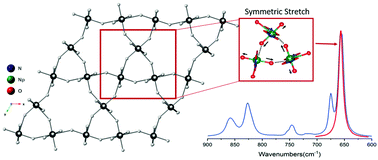Use of vibrational spectroscopy to identify the formation of neptunyl–neptunyl interactions: a paired density functional theory and Raman spectroscopy study†
Abstract
Actinyl–Actinyl interactions (AAIs) occur in pentavalent actinide systems, particularly for neptunium (Np), and lead to complex vibrational signals that are challenging to analyze and interpret. Previous studies have focused on neptunyl–neptunyl dimeric species, but trimers and tetramers have been identified as the primary motif for extended topologies observed in solid-state materials. Our hypothesis is that trimeric and tetrameric AAIs lead to the additional signals in the vibrational spectra, but this has yet to be explored systematically. Herein, we investigate three different neptunyl–neptunyl subunits (dimeric, trimeric, tetrameric) and determine the vibrational frequencies of the O![[double bond, length as m-dash]](https://www.rsc.org/images/entities/char_e001.gif) Np
Np![[double bond, length as m-dash]](https://www.rsc.org/images/entities/char_e001.gif) O stretches using both computational and experimental approaches. Density Functional Theory (DFT) was used to identify distinct vibrational motions related to specific neptunyl oligomers and compared to previous literature precedent from Np(V) in HClO4 and HCl systems. The vibrational behavior of Np(V) in HNO3 was then evaluated via Raman spectroscopy. As the solution evaporated signals were linked to trimeric and tetrameric models. Solid phases produced in the evaporation include (NpO2)2(NO3)2(H2O)5 and newly identified crystalline phase, Na(NpO2)(NO3)2·4H2O (NpNa). The combined computational studies and vibrational analysis provide evidence for unique observable vibrational bands for each polymerized subunit, allowing us to assign spectral features to trimeric and tetrameric models within three different simple anionic systems.
O stretches using both computational and experimental approaches. Density Functional Theory (DFT) was used to identify distinct vibrational motions related to specific neptunyl oligomers and compared to previous literature precedent from Np(V) in HClO4 and HCl systems. The vibrational behavior of Np(V) in HNO3 was then evaluated via Raman spectroscopy. As the solution evaporated signals were linked to trimeric and tetrameric models. Solid phases produced in the evaporation include (NpO2)2(NO3)2(H2O)5 and newly identified crystalline phase, Na(NpO2)(NO3)2·4H2O (NpNa). The combined computational studies and vibrational analysis provide evidence for unique observable vibrational bands for each polymerized subunit, allowing us to assign spectral features to trimeric and tetrameric models within three different simple anionic systems.



 Please wait while we load your content...
Please wait while we load your content...
